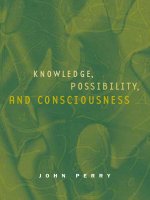the mit press truth and justification oct 2003
Bạn đang xem bản rút gọn của tài liệu. Xem và tải ngay bản đầy đủ của tài liệu tại đây (1.55 MB, 350 trang )
Jürgen Habermas
Habermas
Truth and Justification
Truth and Justification
translated by Barbara Fultner
translated by Barbara Fultner
,!7IA2G2-aidbii!:t;K;k;K;k
Truth and Justification
Jürgen Habermas
Jürgen Habermas has developed the theory of communicative action
primarily in the context of critical social and political theory and
discourse ethics. The essays collected in this volume, however, focus
on the theory’s implications for epistemology and metaphysics. They
address two fundamental issues that have not figured prominently
in his work since the early 1970s. One is the question of naturalism:
How can the ineluctable normativity of the perspective of agents inter-
acting in a linguistically structured lifeworld be reconciled with the
contingency of the emergence and evolution of forms of life? The other
is a key problem facing epistemological realism after the linguistic
turn: How can the assumption that there is an independently existing
world be reconciled with the linguistic insight that we cannot have
unmediated access to “brute” reality?
Truth and Justification collects Habermas’s major essays on these topics
published since the mid-1990s. They offer detailed discussions of
truth and objectivity as well as an account of the representational
function of language in terms of the formal-pragmatic framework he has
developed. In defending his post-Kantian pragmatism, Habermas
draws on both the continental and analytic traditions and endorses a
weak naturalism and a form of epistemological realism.
Jürgen Habermas is Professor Emeritus of Philosophy at the University
of Frankfurt and Professor of Philosophy at Northwestern University.
Studies in Contemporary German Social Thought
Of related interest
Global Justice and Transnational Politics
edited by Pablo De Greiff and Ciaran Cronin
If globalization is to be a benefit and not a burden to humankind, it must be
governed by global institutions that are perceived by all people to be democratic
and just. But before we can create such institutions, we must imagine them,
and that requires a rethinking and extension of normative political theory. Global
Justice and Transnational Politics encourages and advances that work.
Communicative Action and Rational Choice
Joseph Heath
Joseph Heath brings Jürgen Habermas’s theory of communicative action into
dialogue with the most sophisticated articulation of the instrumental conception
of practical rationality—modern rational choice theory.
Language and Reason: A Study of Habermas’s Pragmatics
Maeve Cooke
Language and Reason opens up new territory for social theorists by providing
the first general introduction to Habermas’s program of formal pragmatics: his
reconstruction of the universal principles of possible understanding that, he
argues, are already operative in everyday communicative practices.
The MIT Press
Massachusetts Institute of Technology
Cambridge, Massachusetts 02142
0-262-08318-3
MIT_Habermas 10/16/03 1:36 PM Page 1
Truth and Justification
Books by Jürgen Habermas included in the series Studies in
Contemporary German Social Thought
Thomas McCarthy, general editor
Philosophical-Political Profiles (1983)
Observations on “The Spiritual Situation of the Age” (editor, 1984)
The Philosophical Discourse of Modernity: Twelve Lectures (1987)
On the Logic of the Social Sciences (1988)
The New Conservatism: Cultural Criticism and the Historians’ Debate (1989)
The Structural Transformation of the Public Sphere: An Inquiry into a Category of
Bourgeois Society (1989)
Moral Consciousness and Communicative Action (1990)
Postmetaphysical Thinking: Philosophical Essays (1992)
Justification and Application: Remarks on Discourse Ethics (1993)
Between Facts and Norms: Contributions to a Discourse Theory of Law and Democracy (1996)
The Inclusion of the Other: Studies in Political Theory (1998)
On the Pragmatics of Communication (1998)
The Liberating Power of Symbols: Philosophical Essays (2001)
The Postnational Constellation: Political Essays (2001)
On the Pragmatics of Social Interaction: Preliminary Studies in the Theory of Communicative
Action (2001)
Religion and Rationality: Essays on Reason, God, and Modernity (2002)
Truth and Justification (2003)
Truth and Justification
Jürgen Habermas
edited and with translations by Barbara Fultner
The MIT Press, Cambridge, Massachusetts
This edition © 2003 Massachusetts Institute of Technology
This work originally appeared under the title Wahrheit und Rechtfertigung, © 1999
Suhrkamp Verlag, Frankfurt am Main, Germany. Chapters 2 and 5 of the German
edition have been omitted; translations of both were included in the volume On the
Pragmatics of Communication (1998). In their place the author has included two new
essays (chapters 2 and 5 of this edition).
The translations of several chapters are based on earlier published translations, as
follows: A translation of chapter 1 by Hella Beiser was published in German
Philosophy since Kant, edited by Anthony O’Hear (Cambridge University Press, 1999).
A translation of chapter 3 by Maeve Cooke was published in the European Journal
of Philosophy (December 2000). A translation of chapter 4 by Peter Dews
was published in European Journal of Philosophy (August 1999).
All rights reserved. No part of this book may be reproduced in any form or by any
electronic or mechanical means (including photocopying recording, or information
storage and retrieval) without permission in writing from the publisher.
This book was set in New Baskerville by UG / GGS Information Services Inc. and
printed in the United States of America.
Library of Congress Cataloging-in-Publication Data
Habermas, Jürgen.
[Wahrheit und Rechtfertigung. English]
Truth and justification / Jürgen Habermas; edited and translated by Barbara Fultner.
p. cm.—(Studies in contemporary German social thought)
Includes bibliographical references (p. ) and index.
ISBN 0-262-08318-3 (hc: alk. paper)
1. Philosophy. I. Fultner, Barbara. II. Title. III. Series.
B3258.H323 W3413 2003
100—dc21
2002190859
10987654321
Contents
Translator’s Introduction vii
Introduction: Realism after the Linguistic Turn 1
1. Hermeneutic and Analytic Philosophy: Two 51
Complementary Versions of the Linguistic Turn
2. From Kant’s “Ideas” of Pure Reason to the “Idealizing” 83
Presuppositions of Communicative Action: Reflections
on the Detranscendentalized “Use of Reason”
3. From Kant to Hegel: On Robert Brandom’s Pragmatic 131
Philosophy of Language
4. From Kant to Hegel and Back Again: The Move toward 175
Detranscendentalization
5. Norms and Values: On Hilary Putnam’s Kantian 213
Pragmatism
6. Rightness versus Truth: On the Sense of Normative 237
Validity in Moral Judgments and Norms
7. The Relationship between Theory and Practice Revisited 277
Notes 293
Index 321
Translator’s Introduction
To write an introduction to a volume to which the author himself
has already written a lengthy introduction may seem superfluous.
However, it is perhaps the very length of Jürgen Habermas’s own in-
troduction to Truth and Justification that warrants a briefer preface.
Moreover, given the nature of the essays collected in this volume, it
is important to situate his work in relation to major current thinkers of
the Anglo-American analytic—or, more aptly, postanalytic—tradition.
This collection, perhaps more than any other by Habermas, is an in-
tervention in and contribution to current debates in what he terms
“theoretical philosophy,” that is, in epistemology, metaphysics, and
philosophy of language. At the same time, these essays elucidate the
connection between Habermas’s moral and practical philosophy
and his epistemology and metaphysics. As such, the volume will be
of interest to analytically oriented philosophers as much as to those
who have followed Habermas’s work in social theory and discourse
ethics.
Habermas continues to be one of the few thinkers today aiming to
develop a comprehensive philosophy. Although his main focus in
this volume is on questions of knowledge and objectivity, these are
always reconnected to issues of moral, social, and political theory
that have occupied Habermas over the last several decades. The essays
cover topics as wide-ranging as epistemological and moral cognitivism,
cultural relativism, legal theory, practical reasoning, and human
rights. Most important, Habermas shows how all these different
issues impinge on one another and how a thoroughgoing pragma-
tism can provide a unified account of a vast array of phenomena. In
doing so, he bridges the gap between so-called continental and ana-
lytic philosophy. On the one hand, he brings together the tradition
of Humboldt, Hegel, and Heidegger with that of Frege, Quine,
Davidson, and Dummett; on the other hand, he plays the two tradi-
tions against one another in order to identify their strengths and
weaknesses. The result is a historically informed conceptual map and
a trenchant diagnosis of the state of debate among contemporary
pragmatists. Finally, the present collection of essays marks certain
shifts in his thinking, in particular regarding his conception of truth.
A distinctive feature of Habermas’s work has been his defense of
enlightenment reason even in the age of what he himself has called
“postmetaphysical thinking.” He has always treaded the narrow path
between objectivism and subjectivism—be it in his social theory and
practical philosophy or, as here, in his epistemology and meta-
physics. That is, on the one hand, he has sought to avoid reducing
social situations or moral issues to mere objectively observable phe-
nomena but instead to theorize them from a participant perspective.
On the other hand, he has been critical of social or ethical theories
that accord too much constitutive authority to the subject or the lin-
guistic community.
1
Thus the purpose of the theory of communica-
tive action has been to address problems of action coordination and
social integration by developing an intersubjectivist theoretical frame-
work that avoids the pitfalls of both objectivism and subjectivism.
From the outset, Habermas has embraced the “linguistic turn” as
the basis for such a framework: The theory of communicative action
situates the roots of rationality in the structures of everyday commu-
nication and regards the critical power of reason to be immanent
in ordinary language. Using the resources of speech act theory,
Habermas understands communicative action in terms of the raising
of criticizable validity claims. Following the publication of The Theory
of Communicative Action in the early 1980s, he went on to develop a
cognitivist moral theory in the form of discourse ethics. The core of
this theory is the so-called Principle of Universalization, according
to which a moral norm is justified if all those affected would assent
viii
Translator’s Introduction
to it under conditions of an ideal speech situation.
2
Moral norms,
unlike ethical values, have a universal and unconditional validity.
At the same time, moral rightness is an epistemic notion. That is, it
is defined in terms of what rational agents would agree on under
(approximately) ideal conditions.
In this collection, Habermas turns to the implications of the the-
ory of communicative action—and, more broadly, of the linguistic
turn—for epistemology and metaphysics. He returns to the problem
of representation and objectivity, an issue he has not addressed in
detail since writing Knowledge and Human Interests. In particular, he
distinguishes a nonepistemic notion of objective validity from the
above notion of moral validity. Having worked out the linguistic and
pragmatic turns in practical philosophy, that is, in the theory of ac-
tion and rationality and in ethics, he wants to do the same for ontol-
ogy and epistemology. In taking this route, he reverses what he takes
to be the dominant approach in both analytic and continental phi-
losophy, namely, to give primacy to theoretical over practical philos-
ophy and, consequently, to develop practical philosophy in the light
of theoretical philosophy, rather than the other way round—or,
more appropriately, rather than developing the two in tandem. His
goal, as these essays make clear, is to steer a middle course between
the Scylla and Charybdis of much contemporary thought shaped by
the linguistic turn, namely, between a pragmatist contextualism that
gives up all claims to objective knowledge and a reductive objec-
tivism that fails to do justice to the participant perspective of agents
in interaction. This raises two central problems: How can the in-
eluctable normativity of the perspective of agents interacting in a
linguistically structured lifeworld be reconciled with the contin-
gency of how forms of life evolve? And how can the assumption that
there is an independently existing world be reconciled with the lin-
guistic insight that we cannot have unmediated access to “brute” re-
ality? Habermas wants to answer both questions from a thoroughly
pragmatist perspective. Indeed, he believes that, for the most part,
the pragmatic turn has still not been adequately realized, and that
this failure accounts for the problems faced by other conetmporary
pragmatists, as his engagement with them here illustrates.
ix
Translator’s Introduction
1 Toward a Postanalytic and Postcontinental Philosophy
A major theme of this collection of essays is Habermas’s continuing
effort to mediate between the analytic and continental traditions of
philosophy, which he regards as complementary and without both
of which his formal pragmatics would not be possible. Here we find
him engaging the views of Heidegger, Gadamer, and Apel, on the
continental side, and Frege, Dummett, Davidson, Putnam, and
Brandom, on the analytic. Towering above all, of course, are Kant
and Hegel as the two main historical figures informing contempo-
rary debate. He identifies two major currents in twentieth-century
philosophy in the wake of the linguistic turn. The first is represented
by Wittgenstein and Heidegger and emphasizes linguistic world-
disclosure, that is, the idea that our access to reality is always filtered
and indeed made possible by our language or conceptual scheme.
As already indicated, this strand jeopardizes the notion of objectivity
since it puts us at the mercy, so to speak, of “Being” or of the gram-
mar of our language games. The second is represented by Quine
and Davidson and veers too far in the direction of objectivity; it em-
braces an empiricist outlook at the expense of doing justice to the
participant perspective of language users (pp. 69ff., 112ff.). In addi-
tion, he identifies a third current, namely, that of Kantian pragma-
tism, represented by Putnam, Dummett, Apel, and others—including
himself. This group takes the linguistic turn seriously not just as a
methodological shift, but as a paradigm shift (p. 69). Proponents of
this third strand seek to do justice both to the constitutive nature of
language and to the objectivity of claims to truth.
The first essay explicitly takes up the complementarity of the ana-
lytic and continental traditions, with Wilhelm von Humboldt emerging
in some sense as the historical hero of the collection. Although lan-
guage has a constitutive function for Humboldt, he also emphasizes
the possibility of cross-linguistic and cross-cultural communication
and retains a notion of objective reference. Habermas does not
make it explicit, but his reading of Humboldt—and especially of
Humboldt’s emphasis on the interchangeability of the dialogical
roles of speaker and hearer—parallels on the continental side his
earlier reading of Mead on the Anglo-American side.
3
Moreover, for
x
Translator’s Introduction
Habermas, Humboldt lays the foundations of the kind of Kantian
pragmatism he defends. Both the hermeneutic and analytic tradi-
tions, however, limit themselves to what Habermas calls the “seman-
tic aspects” of language (p. 62) and treat pragmatics as secondary.
Insofar as Humboldt argued that there are three aspects or levels of
language, namely, world-disclosure (taken up by hermeneutics),
representation (taken up by formal semantics), and pragmatics, his
account goes beyond these two traditions.
What is missing from the continental tradition is an adequate ac-
count of the representational function of language, of reference
and propositional truth (p. 61). For this purpose, Habermas draws
on the analytic tradition, particularly on the work of Hilary Putnam.
He stresses that sameness of reference is a formal pragmatic presuppo-
sition of communication, and this presupposition is independent of
the specific—and possibly divergent—descriptions that two speakers
may associate with a term or referent. Indeed, for two speakers to
disagree about the appropriate description of a referent presup-
poses that they are referring to the same thing.
4
The most salient difference between analytic and continental
thought, according to Habermas, is that the analytic tradition does
not engage in cultural critique (p. 79). If we accept this characteriza-
tion, then Habermas shows himself to be a decidedly continental
thinker. Despite the focus on theoretical philosophy, there is a pal-
pable sense of the political throughout the volume, starting with the
introduction’s concluding section of legal theory all the way to the
final essay’s observations on the relationship between theory and
practice and on the philosopher’s role as public intellectual. The
connection between Habermas’s epistemology and his social-political
theory is increasingly foregrounded in the later essays. The final
three essays are, albeit in different ways, intended to show how the
main themes of the volume are connected to the bulk of Habermas’s
oeuvre in social theory and moral philosophy.
2 Kantian Pragmatism
Habermas is one of several contemporary “Kantian pragmatists.” It is
therefore not surprising that his debate with philosophers like
xi
Translator’s Introduction
Hilary Putnam or Robert Brandom is cast in terms of how to “prag-
matize” or, as he puts it, “detranscendentalize” Kant. What follows,
in other words, from understanding the transcendental conditions
of possibility of our experience as something in the world, of situat-
ing them in our practices (pp. 18, 20ff.)? The first part of essay 2
contains a detailed account of his appropriation of Kant. On the
one hand, Kant’s necessary subjective conditions of objective experi-
ence are transformed and given the “quasi-transcendental” role of
intersubjective conditions of linguistic interpretation and communica-
tion. Yet on the other hand, if taken too far, this detranscendental-
ization leads to undesirable consequences. As the titles of essays 3
and 4 suggest, one might say that we must find a middle road be-
tween Kant and Hegel. Habermas argues that Hegel was right to his-
toricize reason, but that he subsequently went too far in the
direction of an “objective idealism” according to which objectivity is
ultimately reduced to intersubjectivity. When “spirit” (Hegel) or
“Being” (Heidegger) or simply lifeworlds or linguistic frameworks
are given too much constitutive authority, the result is linguistic de-
terminism and cultural and epistemological relativism. Situating
transcendental features of experience in local forms of life raises the
problem of how to theorize an objective world existing indepen-
dently of our conceptual schemes or practices. If what we know de-
pends not merely on universal structures of the mind, but on the
conceptual articulation of our language—since this articulation is
what gives us access to “reality” in the first place—there are as many
ways of knowing as there are languages. If these languages further-
more are regarded as incommensurable, the concept of objectivity
loses all bite and we are left with relativism. Even though Habermas,
too, argues that we have no “uninterpreted” or direct access to real-
ity, but that our grasp of how things are in the world is always medi-
ated through language, he rejects relativism in epistemology as
much as in moral theory.
Habermas argues the above problems follow not from the project
of detranscendentalization per se, but from a (continued) privileging
of the representational model of knowledge. According to this model,
which has traditionally gone hand in hand with the correspondence
xii
Translator’s Introduction
theory of truth, knowledge is a matter of correctly representing the
world. Habermas argues that this privileging is present even in au-
thors who claim to have overcome this model. Indeed, Habermas
makes the (strong) claim that even pragmatically oriented analytic
philosophers from Quine and Davidson to Sellars and Brandom re-
main too caught up in the representational paradigm and thus do
not fully take the linguistic-pragmatic turn (see his introduction,
and essays 2 and 3). Even the most promising pragmatic approaches
such as Brandom’s inferentialism, he maintains, ultimately subscribe
to what Habermas regards as an objectivist understanding of agency
that does not do justice to the intersubjective, dialogical nature of
communication (essay 4). The threats of relativism and its converse,
objectivism, in other words, both follow from an insufficiently thor-
ough pragmatism.
Habermas counters the representational model with a pragmatic
conception of knowledge. The pragmatist deflation of Kantian tran-
scendental analysis shows how the background structures of our life-
world are embodied in our practices and activities and emphasizes
the participant perspective. Just as Habermas’s analysis of moral dis-
course involved the formal pragmatic presuppositions interlocutors
must make, so the pragmatic presuppositions governing our epis-
temic practices play a central role here, first and foremost the pre-
supposition of a single objective world that is the same for everyone.
This presupposition lies at the core of our ability to refer to objects
in the world at all and, as such, underlies the representational func-
tion of language. This representational function of language, how-
ever, for Habermas, must remain tied to “contexts of experience,
action, and discursive justification” (p. 26). Thus a strictly causal the-
ory of reference is unacceptable to him. More important, in the
present context, it means that our empirical knowledge of the world
and our linguistic knowledge must be regarded as interdependent.
Not only does language make possible our access to reality, but our
coping with the world in turn has the power to lead us to revise our
linguistic practices (essay 6). Language does not (fully) determine
what we can know of the world or what the world is for us. Rather, we
learn from experience, and this empirical knowledge can lead us to
xiii
Translator’s Introduction
revise the meanings of the terms we use. This is why Habermas refers
to the world-disclosure of language as “weakly transcendental.”
Crucial for accounting for the revisionary power of experience
relative to language is the role Habermas accords to problem solving.
It is the key activity underlying knowledge acquisition. We en-
counter the world first in our engaged coping, and—often—we
encounter it as a source of resistance. That the world provides resis-
tance when we deal with it means that “the way the world is” is not
simply up to us. Rather, reality constrains our practices in tangible
ways, and this provides the foothold for a robust notion of objectiv-
ity. This is crucial for learning. The resistance of the objective world
is analogous to the resistance we may encounter when others criti-
cize the claims we raise in discourse, and Habermas uses this analogy
to argue for the unconditionality of moral validity (essay 6).
This pragmatist conception of knowledge has ontological implica-
tions. Working out an adequate notion of objectivity leads Habermas
to endorse a “weak naturalism” to complement his epistemological
realism. Weak naturalism is a form of naturalism insofar as it views
nature and culture as continuous with one another. Culture evolves
naturally. Here, too, learning is a central metaphor: Our sociocul-
tural form of life has evolved from prior forms through natural
learning processes. Habermas’s is a weak naturalism because he
wants to refrain from making any sort of reductionist claims about
social practices (such as reducing them to merely observable behav-
ior); they are to be analyzed from the participant perspective as
norm-governed practices. Similarly, weak naturalism is supposed to
be neutral with regard to the mind–body problem. The idea is that
once we connect transcendental pragmatism with weak naturalism,
we can give an account of how reality imposes constraints on our
practices (p. 30). The paradigmatic representatives of “strong” natu-
ralism, by contrast, are Quine and Davidson, who, according to
Habermas, explain human behavior naturalistically, assimilating
normative social and linguistic practices to observable events in the
world. By seeking to eliminate all normative elements from its expla-
nations, strong naturalism fails to do justice to the participant per-
spective, whereas weak naturalism takes seriously the normative
self-understanding of agents in interaction.
xiv
Translator’s Introduction
3 Objective and Normative Validity: A Revised Conception of
Truth
Most of Habermas’s work following The Theory of Communicative Ac-
tion in the 1980s and early ’90s focused on developing discourse
ethics. In terms of validity, this meant working out what is involved
in raising and vindicating normative rightness claims. The focus, in
other words, was on normative validity (Sollgeltung), on what one
ought to do. The question of truth, in contrast, for him is a question
about objective validity (Wahrheitsgeltung). Here, the issue of normativ-
ity becomes tricky. Of course, the question of objective validity has
to do with what one ought to believe or take to be true, and to that
extent, it makes sense to speak of truth as a “normative” concept.
However, truth, for Habermas, must not be assimilated to (merely)
holding true. Ultimately, objective validity is a matter of what is, in
fact, true, not of what we take to be true (despite the fact that we can
confidently say that some of our truths have replaced earlier beliefs
that we now know were false, and the fallibilist insight that, for all we
know, our own beliefs may be similarly replaced in the future).
Truth, in contrast to normative rightness, in other words, is not an
epistemic notion—a point to which I return below.
References to truth, objectivity, and the cognitive or representa-
tional dimension of language, to be sure, have always figured in
Habermas’s accounts of language and communication as well as in
his critiques of other approaches. Thus, for example, he criticizes
analytic philosophy of language and in particular truth-conditional
approaches to semantics for privileging the representational dimen-
sion of language.
5
However, at least since writing “Wahrheitstheo-
rien,”
6
Habermas has not addressed in further detail the question of
the nature of truth. Rather, he has generally confined himself to the
view that in raising a truth claim, a speaker claims that some state of
affairs or fact obtains. In “Wahrheitstheorien,” Habermas already re-
jected both correspondence and coherence theories of truth, and
he does so still in essays 5 and 6. On the one hand, correspondence
is too strong a notion inasmuch as it assumes the possibility of direct
access to “brute” or “naked” reality. On the other hand, a coherence
theory of truth fails to capture important aspects of our concept of
xv
Translator’s Introduction
truth, even though it looks to be one of the implications of the lin-
guistic turn: Once we grant that there is no direct, but only linguisti-
cally mediated access to reality, it seems that any belief or statement
can be corroborated only by other beliefs or statements and that
thus a coherence theory of truth is the only kind available to us. Yet
coherence is too weak a notion for truth inasmuch as, according to
Habermas, statements are true not because they cohere with other
statements we accept, but because the states of affairs they describe
actually obtain (even though they can be established only by means of
other statements).
In “Wahrheitstheorien,” Habermas thus infamously coined the
term “consensus theory of truth,” which has caused a fair amount of
confusion about and misunderstanding of his position. This early
essay should be read as presenting not so much a theory of truth as a
theory of justification.
7
Possibly fueling the confusion, Habermas
himself did espouse what he subsequently called a “discursive” con-
ception of truth until the mid- to late-1990s, according to which
truth is ideal warranted assertibility—a view he shared with Hilary
Putnam, among others. In response to criticism, Habermas has since
abandoned this epistemic conception of truth. As he argues at
length in essays 2 and especially 6 the discursive conception as for-
mulated hitherto is inadequate. In particular, the discursive or con-
sensus theory of truth misleadingly suggests that we take a
proposition to be true because it is or can be agreed to by all those
concerned, whereas in fact, we ought to agree to a proposition be-
cause it is true, not the other way around. This change of mind is in
large part what has prompted him to return to epistemology and
metaphysics in order to work out a better pragmatist conception of
truth; he now takes it that “the discursive conception of truth is due
to an overgeneralization of the special case of the validity of moral
judgments and norms” (“Introduction,” p. 8). The validity of the lat-
ter is exhausted by ideal warranted assertibility: A moral claim is nor-
matively right if and only if all those affected would agree to it under
approximately ideal conditions of discourse. There are no facts in-
dependent of the (ideal) community of those affected to which nor-
mative rightness claims purport to refer. But talk of truth, in contrast
to that of normative rightness, has certain specific ontological
xvi
Translator’s Introduction
connotations: It presupposes reference to a single objective world
that exists independently of our descriptions and is the same for all
of us. This realization has led Habermas to acknowledge the need
for a theory of reference to supplement the theory of communica-
tive action. Hence he endorses a direct theory of reference as devel-
oped by Hilary Putnam, which allows for sameness of reference
under different descriptions. This, too, is clearly a necessary presup-
position of discourse about whether what we say is true.
Truth figures at different levels in Habermas. On the one hand,
truth plays a role in discussions of the nature of the theory of mean-
ing. Habermas is drawn to the analytic tradition because it can provide
a theory of meaning that, in particular, accounts for the representa-
tional dimension of language, which the continental linguistic tradi-
tion tends to neglect. Furthermore, Habermas especially applauds
the recognition, since Frege, of the internal connection between
meaning and validity. Although truth, as one of the three validity
claims, is indispensable to the theory of communicative action,
Habermas has argued against taking truth as a semantic primitive.
Rather, it is but one dimension of validity. A truth-conditional
semantics as developed by philosophers of language from Frege to
Davidson is too narrow, in his view, for it privileges the representa-
tional dimension of language over its expressive and communicative
dimensions.
8
For Habermas, communication, action, and representation are
equiprimordial. This has been a hallmark of his conception of speech
acts since the 1970s: In performing a speech act, a speaker repre-
sents a state of affairs, establishes an intersubjective relation with a
hearer, and expresses her intention. In other words, she raises three
validity claims: a claim to truth, to normative rightness, and to sin-
cerity. The insistence on these three mutually irreducible validity
claims forms a cornerstone of Habermas’s conceptual system. And it
is this view that continues to set him apart from the analytic philoso-
phers he discusses. In one way or another, it lies at the bottom of his
critique of Quine and Davidson as well as of Brandom and even Put-
nam. All are seeking to find a common denominator or to level the
conceptual landscape in ways that Habermas rejects. Quine and
Davidson, in his view, err on the side of objectivism by turning the
xvii
Translator’s Introduction
communicative actions of others into mere observable behavior;
Brandom assimilates norms of rationality to norms of action; and
Putnam levels the fact-value distinction by associating value judg-
ments with “ought-implying facts.”
On the other hand, Habermas also discusses truth at the level of
metaphysics and ontology. This is the case, for instance, when he is
trying to elucidate what is involved in truth as a validity claim. The
question here is how should truth be defined? What is truth on a
pragmatist account that nonetheless wants to embrace epistemologi-
cal realism? For a pragmatist, of course, this very question is ill put.
Indeed, one might argue that a major advantage of Habermas’s pres-
ent account over that he offered in “Wahrheitstheorien” is that he
no longer provides a definition of truth or equates it with anything.
Rather, not unlike Brandom in Making It Explicit, he directs our at-
tention to how the concept of truth functions, both in everyday cop-
ing and in discourse. Whereas in the latter context, we are aware of
the “cautionary” uses of the truth predicate and of the fallibility of
our claims, the unconditionality of truth is most evident in practical
contexts of ordinary coping. There, we presuppose certain truths,
practical certainties, as unconditionally valid. As Habermas suc-
cinctly puts it, “We do not walk onto any bridge whose stability we
doubt” (p. 39). This unconditional acceptance is the pragmatic
corollary of a realist conception of truth.
Habermas is an epistemological realist in another respect as well:
The objects we can refer to may fail to meet the descriptions we asso-
ciate with them. This is the core of his fallibilism; it is also where he
draws on Putnam’s theory of reference. In defense of his version of
a pragmatic conception of truth, he argues that the connection between
truth and justification is epistemically, but not conceptually necessary
(p. 38). In other words, truth may always “outrun” justified belief,
even under (approximately) ideal conditions, but he nevertheless
insists on the fact that from the agent’s perspective, practical cer-
tainties are and must be taken to be true absolutely at the risk of in-
capacitation. It is only in discourse that such practical convictions
come under a fallibilist proviso.
Finally, Habermas considers himself to be a “conceptual nominal-
ist” rather than a conceptual realist (p. 31). This follows, first, from
xviii
Translator’s Introduction
his commitment to the revisability of language by experience. But it
also means, second, that the world does not consist of facts but of
things. A fortiori, then, for Habermas, facts are not things. This view
is clearly reminiscent of Davidson’s claim that “nothing, no thing,
makes our sentences true.”
9
Although facts, for Habermas, are what
is represented in true statements, he does not mean to reify or hypo-
statize the notion of fact. In a sense, both Davidson and Habermas
allow that facts—that things are thus and so—are what make sen-
tences true; both endorse realist views about truth; and both main-
tain that there is a mind- and language-independent objective world.
Moreover, both are antireductionists: Like Habermas, Davidson de-
fends the mutual irreducibility and equiprimordiality of subjectivity,
objectivity, and intersubjectivity. Nonetheless, his epistemology is
more strongly naturalistic and less pragmatic that Habermas’s. On
the other hand, he is more suspicious of “fact-talk” than Habermas
and would rather do without it entirely. In this regard, Davidson is
arguably more metaphysically abstemious if not postmetaphysical.
Much of the interest of the present volume lies in Habermas’s
clarification of the—often subtle—differences between his own
position and similar approaches. One must, for this very reason, be
careful to distinguish substantive differences from differences in em-
phasis between Habermas and his sparring partners. These are in a
sense, to borrow Habermas’s phrase, “domestic disputes.” His and
Robert Brandom’s accounts of objectivity, for example, can and per-
haps should be regarded as complementary. Brandom argues that
there is a “structural objectivity” built into our practices of giving
and asking for reasons; for him, the distinction between something’s
being true and being taken to be true is a pragmatic one, built into
the structures of communication. To that extent, his account is com-
patible with Habermas’s own pragmatic account of objectivity. Ac-
cording to the latter, the formal presupposition of a single objective
world existing independently of us is, after all, also a structural fea-
ture of discourse.
10
Another example is the disagreement with Putnam about truth.
Habermas criticizes Putnam’s account of the objectivity of value (as
the inverse of the value-ladenness of facts) and his assertion that there
are “ought-implying facts” and that, therefore, value judgments can
xix
Translator’s Introduction
be true or false. Against Putnam, Habermas argues that there are “dif-
ferent senses in which judgments can be correct” (p. 224). Norms
must not be assimilated to facts, for the facts are not “up to us” in the
way that moral or ethical norms are. The meaning of truth, as he puts
it, is not exhausted by reaching consensus. At issue in this dispute is
whether it is legitimate to allow for different types of truth that in turn
require different types of justification or whether “truth” is a notion
that applies to statements about the objective world only whereas
moral judgments, though they have cognitive content, are subject to a
different kind of validity. Some have argued along these lines that, in
the moral domain, Habermas has been defending a peculiar brand of
cognitivism, since he has consistently denied that moral claims are
truth-evaluable when truth-evaluability is generally thought to be the
hallmark of moral cognitivism. What difference it makes whether we
talk about, say, moral or aesthetic truth or moral rightness and aesthetic
authenticity, as long as we recognize that they are subject to justification
in terms of different kinds of reasons, remains an open question.
11
Perhaps a more salient point of disagreement between Habermas
and Putnam in their ongoing debate is their respective understandings
of pluralism, as this collection’s essay and especially Putnam’s re-
sponse to it show.
12
Putnam seems to have an almost instrumentalist
conception of the value of pluralism. For him, it involves more than
mere tolerance. A consistent pluralist cannot hold that some other
form of life, religious tradition, or sexual orientation is “wrong.”
Above and beyond this “minimal pluralism,” however, he also claims
that a pluralist must accept that other forms of life, religion, or sex-
ual orientation may have insights available to them that are not avail-
able to her, but that may be of use to her and to her own community.
13
This sheds new light on Putnam’s dictum to “let a thousand flowers
bloom.” The value of pluralism—rather like the value of pluralism
in scientific inquiry—is that it can help us in our discovery of the
good life. But a Habermasian, according to Putnam, can approach a
value judgment from another community or culture in only two
ways: She can ask either (a) whether it is deontologically admissible,
that is, whether it violates any universal norms, or (b) whether it
contributes to a collective form of life that is in the interest of all
those affected.
14
This, however, is too narrow an understanding of
xx
Translator’s Introduction
cross-cultural dialogue according to Putnam. This is no doubt the
case, but a Habermasian need not be confined to this narrow con-
ception. Putnam does not consider Habermas’s emphasis on learn-
ing processes, on the one hand, and on the dialogical nature of
communication, be it intra- or intercultural, on the other. These at
least prima facie surely allow for the possibility of our learning by in-
teracting not only with the objective world, but also with others. Just
as we are able to revise our linguistic knowledge in light of new em-
pirical knowledge, so surely we must be able to revise our moral and
ethical knowledge in light of our interactions with one another. Ulti-
mately it is this ability that lies at the cognitivist heart of a realist
epistemology and universalist moral theory.
Essays 1, 3, and 4 have been published elsewhere in translations by
others. Habermas himself penned an English version of essay 7.
While I have learned from each of these translations, I have revised
all in an effort to give the volume unity of style and to correct for
some discrepancies with the published German original. A few terms
presented particular difficulties that should be mentioned here.
(1) Habermas uses two terms for “validity,” Geltung and Gültigkeit. There
is a latent attempt to use them to mark two distinctions, namely, on
one hand, between the objective validity of a claim and its de facto
“validity for us,” its social acceptance or force, and, on the other, be-
tween objective and normative validity. The latter, in other words, is
a distinction within the dimension of validity in general. However,
Habermas does not draw either distinction systematically. (2) For
the most part, I have rendered Aussage as “statement,” though some-
times “proposition” or “assertion” were more appropriate. Thus, for
example, Habermas distinguishes between moralische Aussagen and
empirische Aussagen, but also associates truth with propositions (Proposi-
tionen) and assertions as distinct from normative rightness and nor-
mative claims, which he explicitly distinguishes from assertions. As
a result, it is somewhat awkward to speak of “moral propositions”
rather than moral claims or statements. (3) The rather different
connotations or, to put it in terms of the Brandom–Habermas de-
bate, inferential relations of terms like practical commitments and prak-
tische Vorhaben (“practical projects” or “undertakings”) potentially
lead to confusion in transposing a philosophical debate from one
xxi
Translator’s Introduction
language into another, one philosophical culture into another, even
challenging one’s faith in the principle of translatability. For the sake
of the English-speaking audience who may be familiar with Bran-
dom’s work, I have tried to cast the debate as much as possible in
Brandom’s original terms without distorting Habermas’s criticisms.
I am grateful to Gary Davis, Cristina Lafont, Sid Maskit, Christoph
Menke, Bill Rehg, and especially Jonathan Maskit for their advice
and assistance with various parts of this manuscript. Finally, I would
like to thank Jürgen Habermas for generously clarifying a number of
points in the text.
xxii
Translator’s Introduction
Introduction: Realism after the Linguistic Turn
The present volume brings together philosophical essays that were
written between 1996 and 2000 and pick up on a line of thought
that I had set aside since Knowledge and Human Interests. With the ex-
ception of the final essay (“The Relationship between Theory and
Practice Revisited”), they deal with issues in theoretical philosophy
that I have neglected since then. Of course, the formal pragmatics
that I have developed since the early 1970s cannot do without the
fundamental concepts of truth and objectivity, reality and reference,
validity and rationality. This theory relies on a normatively charged
concept of communication [Verständigung], operates with validity
claims that can be redeemed discursively and with formal-pragmatic
presuppositions about the world, and links understanding speech
acts to the conditions of their rational acceptability. However, I have
not dealt with these themes from the perspective of theoretical
philosophy. I have pursued neither a metaphysical interest in
the being of Being, nor an epistemological interest in the knowl-
edge of objects or facts, nor even the semantic interest in the form
of assertoric propositions. The linguistic turn did not acquire its sig-
nificance for me in connection with these traditional problems.
Rather, the pragmatic approach to language [Sprachpragmatik]
helped me to develop a theory of communicative action and of ra-
tionality. It was the foundation for a critical theory of society and
paved the way for a discourse-theoretic conception of morality, law,
and democracy.
This explains a certain one-sidedness of my theoretical strategy,
which the essays in this volume are meant to redress. They revolve
around two fundamental questions of theoretical philosophy. On
the one hand, I here take up the ontological question of naturalism:
As subjects capable of speech and action, we “always already” find
ourselves in a linguistically structured lifeworld. How can the norma-
tivity that is unavoidable from the perspective of the participants in
this lifeworld be reconciled with the contingency of sociocultural
forms of life that have evolved naturally? On the other hand, I turn
to the epistemological question of realism: How can we reconcile
the assumption that there is a world existing independently of our
descriptions of it and that is the same for all observers with the lin-
guistic insight that we have no direct, linguistically unmediated ac-
cess to “brute” reality? Needless to say, I deal with these topics from
within the formal-pragmatic perspective.
I Communication or Representation?
Once Frege replaced the mentalistic via regia of analyzing sensa-
tions, representations, and judgments with a semantic analysis of lin-
guistic expressions and Wittgenstein radicalized the linguistic turn
into a paradigm shift,
1
Hume and Kant’s epistemological questions
could have taken on a new, pragmatic significance. In the context of
lived practices, of course, they then would have lost their primacy
over questions in the theory of communication and action. Yet even
within philosophy of language, the traditional order of explanation
has persisted. As ever, theory takes precedence over practice, repre-
sentation over communication; and the semantic analysis of action
depends on a prior analysis of knowledge.
Still caught up in the tradition of Platonism, the philosophy of
consciousness privileged the internal over the external, the private
over the public, the immediacy of subjective experience over discur-
sive mediation. Epistemology rose to the rank of a First Philosophy,
while communication and action were relegated to the realm of ap-
pearances, thus retaining a derivative status. After the transition
from philosophy of consciousness to philosophy of language, it
seemed to make sense not to turn the hierarchy of explanatory
2
Introduction









